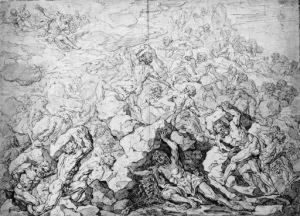Bernard-Eugene-Ant. Rottiers Paintings
Bernard-Eugène-Antoine Rottiers, often known simply as Eugène Rottiers, was a Belgian historical painter and engraver who lived during the late 18th and early to mid-19th centuries. Born on October 27, 1769, in Antwerp, Belgium, Rottiers was part of the artistic movement of his time that was characterized by a strong interest in historical and classical subjects, influenced by the neoclassical style.
Rottiers received his early education in the arts at the Royal Academy of Fine Arts in Antwerp, where many prominent artists of the era were trained. The Academy was known for its rigorous program that emphasized the classical principles of art, rooted in the study of the antique and the works of the Renaissance masters. This background likely influenced Rottiers' own artistic style and interests.
During his career, Rottiers produced a number of historical paintings that were well received. He was particularly skilled in depicting scenes from ancient history and mythology, and he also created a number of engravings. His work reflects the neoclassical preoccupation with harmony, clarity, and the idealization of the human figure.
Despite his contributions to the art world during his lifetime, Rottiers is not as widely remembered as some of his contemporaries. This may be due to the changing tastes in art that shifted towards Romanticism in the early 19th century, a movement that embraced emotion and individualism over the classical restraint and order that characterized Rottiers' work.
Rottiers passed away on February 3, 1850, in Antwerp. While specific details about his life and career are not as plentiful as for some other artists of his time, his surviving works continue to be a testament to the skill and aesthetic sensibilities of neoclassical artists active in Belgium during the late 18th and early 19th centuries.
